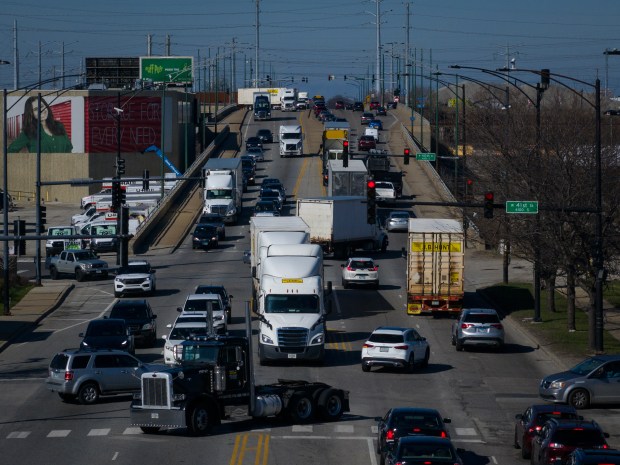Chicago is building what climate scientists say could be the country’s best system for monitoring tailpipe pollution from diesel trucks.
But even though the air monitors have arrived, the city doesn’t expect to finish installing them for another year. Meanwhile, community members who are supposed to help operate the network and disseminate the findings are being asked to work for free when funding runs out.
In an email sent to community groups four days after President Donald Trump’s inauguration, and later obtained by the Chicago Tribune, the city offered only its “hope” that data from the monitors “will remain accessible to the public.”
The email rattled activists who’ve been demanding air monitors for decades to document their case for electric truck mandates and land-use policies that disperse warehouses and truck traffic instead of concentrating them in Black and brown neighborhoods.
It left even supporters of Mayor Brandon Johnson wondering if he’s sidelining his promise for an environmental justice crusade as he battles a rebellious City Council and a Chicago-bashing U.S. president.
Any backsliding would be especially worrisome for activists as Trump’s EPA abandons federal environmental justice programs, shifting more responsibility to local government.
Nina Idemudia, chief executive officer of the Center for Neighborhood Technology, said two near-simultaneous City Hall events stoked concern among environmentalists.
The first was the November resignation of Raed Mansour, who’d been leading the air monitoring program. In his first interview since leaving the city, Mansour said he’d been forced out.
The second event was the Department of Public Health’s Healthy Chicago 2025 strategy document released in December. It did not mention air quality monitoring and relegated climate change and environmental justice to a listing in the appendix of prior city commitments.
“If there has been a shift, they need to be honest about that,” said Idemudia, whose nonprofit has been helping plan the air quality monitoring network.
“If there hasn’t been a shift, they need to be more transparent about what the new timeline is to get these things done,” she said.
“I think there’s a little bit of fear, especially from our smaller nonprofit groups, that if they were to criticize the city publicly, it could harm relationships,” Idemudia said.
With plans to deploy at least 200 monitors mainly in the city’s most polluted neighborhoods, and four weather stations, the network “will provide information that most cities in the world don’t have,” said Daniel Horton, a Northwestern University climate scientist.
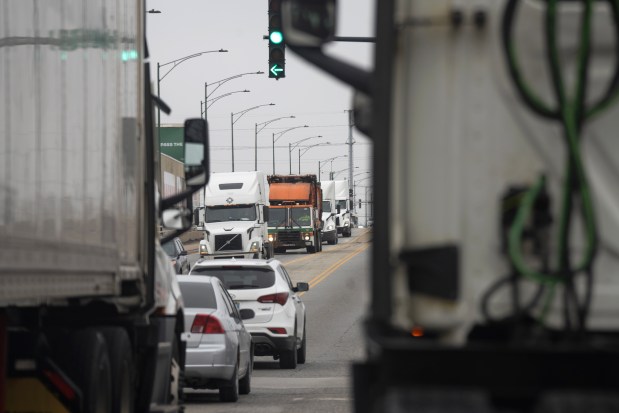
A year and a half ago Johnson promised at a City Hall news conference to step up enforcement of pollution complaints and to consider the cumulative impacts of pollution on neighborhoods when making decisions.
On air monitors, the city went through a period of regrouping after Mansour resigned. It’s moving ahead with the program now, Grace Adams, a spokeswoman for the health department, said in early February.
Adams clarified the department’s Jan. 24 email to community groups by saying pollution data “will become available publicly” once the monitors have been installed and fully tested.
The department is planning five years of open access to the monitoring data starting in early 2026, she said.
The Healthy Chicago 2025 planning document didn’t mention the monitors because they won’t be fully deployed until next year, Adams said.
In the meantime, Adams said, public health officials will focus on what she called the top reasons Black Chicagoans live an average of 11.4 years less than everybody else in the city. These include chronic disease and homicide.
For some activists and elected officials, Adams’ assurances don’t erase what they view as decades of the city’s broken promises on air pollution.
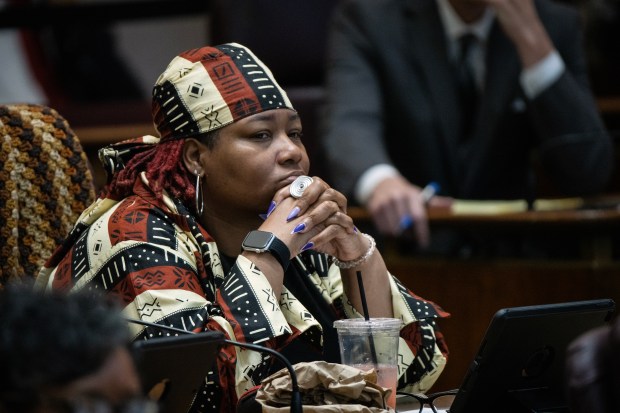
“They don’t care about Black and brown children dying from asthma and how we’re getting asthma at a higher rate,” said Ald. Jeanette Taylor, 20th, whose ward includes parts of Englewood.
“They let the railroads and trucks come into our communities to do just what they want,” Taylor said.
Matt Hart, executive director of the Illinois Trucking Association, is on high alert.
“If you want to take trucks off the road, we can do that,” said Hart, whose members, according to the American Transportation Research Institute, provide 1 in 15 jobs in the state.
“Just let us know which trucks to take off the road first, the ones delivering your medicine or the ones delivering your food,” Hart said.
Mansour said that before his resignation, he purchased 154 Clarity Node-S cellular-capable and solar-powered monitors to be mounted on street light poles.
The monitors measure PM2.5 particle pollution that damages hearts and lungs and nitrogen oxide that contributes to asthma.
When the monitors arrived on Oct. 16, Mansour said, the city stored them in a warehouse on Goose Island.
The city plans to begin outdoor testing and calibration when warm weather arrives this spring, and then to start deploying the monitors, according to Adams.
Serap Erdal of the University of Illinois Chicago agreed to provide 100 additional monitors using separate federal funds.
Together, Erdal and the city plan to deploy about 220 monitors around the city and to use the remaining monitors for testing and replacements. They also plan to jointly publish results on the monitor company’s online dashboard.
For its part, the city planned to spend $2.1 million, Mansour said.
About half came from the sale of general revenue bonds to purchase the monitors and set them up to run for an expected lifespan of five years.
The other half, to set up a community advisory panel to help operate the monitors and publish the results, is coming from the federal government’s COVID-19 stimulus spending.
Chicago plans to spend down all this COVID money during 2025, Adams said.
The city will use the money to pay existing vendors like the Illinois Public Health Institute and Mount Sinai Hospital to organize the air monitor advisory panel, and then to pay expenses to a dozen community groups who’d serve on it.
Sinai, according to its contract, would receive $150,000. This would cover its own costs and compensation plus payments to two West Side community groups to be on the advisory panel.
As things stand now, the advisory panel members could have to volunteer to work for free after receiving their initial payment this year, Adams said.
Mansour wanted to cover the whole city but to concentrate on neighborhoods identified in Chicago’s Cumulative Impact Assessment and elsewhere as those most burdened by pollution and most vulnerable to its effects. That means mainly the South and West sides.
The U.S. Environmental Protection Agency currently runs just four air quality monitors in the city.
Mansour, who was hired by the health department 11 years ago, grew up in the Hegewisch neighborhood on the city’s Southeast Side.
He specialized in neighborhood coalition-building around public health threats like extreme heat, lack of equitable tree cover and air pollution. One recent high point was representing Chicago at a White House summit meeting on extreme heat.
Johnson stepped into the limelight, too, in 2023, saying in a statement for Bloomberg Philanthropies and other charitable groups that the monitors “will improve understanding of air quality variations by neighborhood, with a focus on heavy-duty vehicle emissions.”
Dr. Olusimbo Ige, who was appointed commissioner of the health department in November 2023, declined to comment for this story.
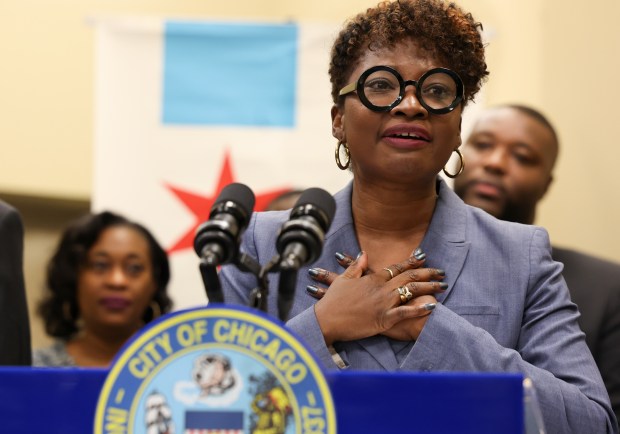
Ige came to Chicago from the Robert Wood Johnson Foundation and, before that, from the New York City Department of Health and Mental Hygiene.
She replaced Allison Arwady, who, according to a Chicago Tribune report, angered Johnson and the Chicago Teachers Union by, in their view, reopening schools too quickly after the COVID-19 outbreak.
Mansour said he was an Arwady protege. But Ige told him directly, he said, that she couldn’t figure out where his extreme heat, tree and air monitoring work should fit into the department’s long-term future.
“She wanted a straightforward permitting and enforcement process with no environmental justice considerations,” Mansour said.
In response, Adams said the health department has a separate unit for permitting, and another for epidemiology and research, but these units routinely work together.
The coup de grace for Mansour, first reported in the Chicago Sun-Times, came in November.
That’s when Bishop Horace Smith, a member of a city health department advisory panel and a pediatric oncologist, told Mansour in a meeting that his preference would be for the city to focus more on food deserts and lead poisoning for kids, and less on air pollution.
“If you’ve made some advances on the technology of monitoring pollution, that’s great,” Smith said in an interview as he recalled his comments from that meeting. “But it’s not my No. 1 priority.”
In his response to Smith, Mansour remembers defending the monitors as a way to identify pollution hot spots. He remembers the conversation as robust, professional and short.
A few days later, Mansour said, a labor relations official from the city told him he’d acted in a disrespectful manner in a public meeting but wouldn’t say to whom. The official told him Ige wanted him to resign and that he would be fired if he didn’t.
The ultimatum came two days after Trump’s reelection and just a week before a tumultuous vote in which the City Council gave Johnson a 50-0 shellacking on his proposal to raise property taxes.
Smith said he was shocked to learn that Mansour had been reprimanded over the incident and later resigned. Nothing that happened at the meeting indicated anything negative, he said, about the city’s continuing commitment to environmental justice.
Adams, the health department spokeswoman, declined to comment on Mansour’s departure. Johnson’s press office didn’t respond to emails seeking comment.
The city plans to meet virtually with community groups on March 7 to discuss the air quality monitors, but many questions remain.
For example, Chicago entered into a legally binding agreement with the U.S. Department of Housing and Urban Development in 2023 to operate the monitors. The city agreed to this to settle a HUD investigation into whether it had engaged in environmental racism.
Anthony Moser, a board member of Neighbors for Environmental Justice in McKinley Park, said Trump’s election means HUD may never enforce this agreement.
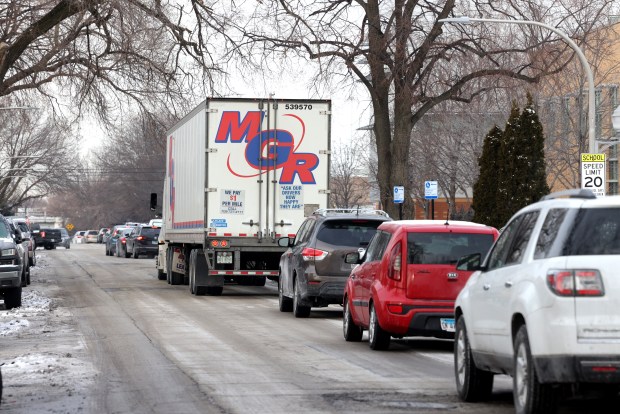
He said this is just one example of how Trump’s anti-environmentalism in the White House has deprived Chicago activists of a major source of leverage over City Hall.
They’re still trying to sort out what’s left.
“We know we’re entering a period of profound uncertainty,” Moser said. “But when we think of things the city can do within its existing capacity, you know, they already have the monitors. All they have to do is hook them up and get started.
“And the community groups are still interested in being a part of this, even if it’s not a guaranteed, paid, funded thing,” Moser said. “People want to be part of it just to see it happen.”
A software engineer by trade, Moser has spent nights and weekends during the last month building a website on which Chicago residents can specify which blocks and even which side of the street need pollution monitors the most. The website went live Feb. 5.
Moser’s group has been volunteering time to help the city plan the monitors for two years, Moser said. The group hopes to participate in the city’s formal advisory panel when it’s set up, he said.
“For us, the important part is that people can make suggestions, and we got it translated so they can do it in Spanish and Chinese, not just in English,” Moser said.
Moser said the city’s websites and phone lines currently accept complaints about air pollution only in English, even though many of the people most affected by pollution speak different languages.
Howard Ehrman worked with Moser on the new website, and he said he intends to use it as an organizing tool.
At age 77, Ehrman knows a lot about organizing. He co-founded the Little Village Environmental Justice Organization in 1994. He was an assistant health commissioner for Mayor Harold Washington, and he’s still a practicing physician.
“Ever since the passage of the Clean Air Act in 1970, no Democratic or Republican governor and no big city mayor have wanted air monitors in the most polluted areas because then they’d have to do something about it,” Ehrman said.
“As mayor, Brandon Johnson has so many other things going on, some of which are his fault and a lot of which aren’t.
“But he hasn’t done anything about air pollution, and he’s not going to unless there’s a mass movement that forces him,” Ehrman said. “So we’re going to create a mass movement as best we can.”
John Lippert is a freelancer.


